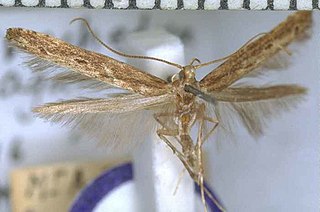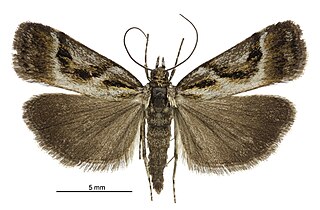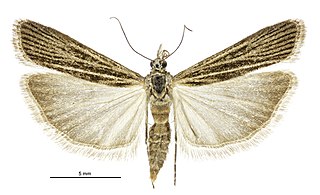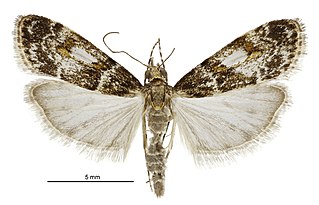
Eudonia octophora is a species of moth of the family Crambidae. It was named by Edward Meyrick in 1884. It is endemic to New Zealand.

Batrachedra agaura is a species of moth in the family Batrachedridae. It is endemic to New Zealand. This species is distributed throughout the country. The species inhabits native forests, especially beech and kanuka forests or manuka scrubland. The larvae of this species are associated with sooty mold and sooty beech scale. It has been hypothesized that the larvae feed on sooty beech scale. However, they may also feed on the sooty mold itself. The adult female is lighter in appearance than the male, and the species shows considerable variation in patterns on the forewing. Adults are on the wing from October to February. They are nocturnal and occasionally attracted to light.

Amblyptilia epotis is a moth of the family Pterophoridae. It is endemic to New Zealand and is found in the South and Stewart Islands. It inhabits mountainous terrain covered in alpine vegetation or alternatively alpine wetland habitat. The adults of this species are on the wing from February to March. In appearance the adults of this species are variable in colour however this species can be distinguished from similar species by the oblique apical streak on its forewings as well as the patch of white on the costa cilia towards the apex of the forewing.

Culladia strophaea is a species of moth in the family Crambidae. It is endemic to New Zealand. The taxonomy of this species is currently uncertain.

Eudonia cymatias is a moth in the family Crambidae. It was named by Meyrick in 1884. This species is endemic to New Zealand.

Eudonia hemicycla is a moth in the family Crambidae. It was described by Edward Meyrick in 1884. This species is endemic to New Zealand.

Eudonia legnota is a moth in the family Crambidae. This species was named by Edward Meyrick in 1884. It is endemic to New Zealand.

Eudonia leptalea is a moth in the family Crambidae. This species is endemic to New Zealand, including the Chatham Islands.

Eudonia microphthalma is a moth in the family Crambidae. It was described by Edward Meyrick in 1884. It is endemic to New Zealand.

Eudonia psammitis is a moth in the family Crambidae. It was named by Edward Meyrick in 1884. Meyrick gives a description of the species in 1885. It is endemic to New Zealand, including the Campbell Islands.

Eudonia alopecias is a moth in the family Crambidae. It was described by Edward Meyrick in 1901. It is endemic to New Zealand and has been found at Aoraki / Mount Cook in February.

Eudonia atmogramma is a moth in the family Crambidae. It was described by Edward Meyrick in 1915. It is endemic to New Zealand.

Eudonia dochmia is a moth in the family Crambidae. It was described by Edward Meyrick in 1905. It is endemic to New Zealand.

Eudonia luminatrix is a moth in the family Crambidae. It was described by Edward Meyrick in 1909. This species is endemic to New Zealand.

Eudonia meliturga is a moth in the family Crambidae. It was described by Edward Meyrick in 1905. This species is endemic to New Zealand.

Eudonia thyridias is a moth in the family Crambidae. It was described by Edward Meyrick in 1905. It is endemic to New Zealand.

Tingena loxotis is a species of moth in the family Oecophoridae. This species is endemic to New Zealand and is found in the North Island. This species is found in gardens and are known to enter houses. Adults are on the wing in December and January. It is classified as "Data Deficient" by the Department of Conservation.

Tingena aletis is a species of moth in the family Oecophoridae. It is endemic to New Zealand and has been collected in the vicinity of Arthur's Pass in the South Island. Adults are on the wing in January.

Tingena penthalea is a species of moth in the family Oecophoridae. It is endemic to New Zealand and has been observed in Wellington and the Tararua Range. The adults of this species are on the wing from December until February.

Tingena pharmactis is a species of moth in the family Oecophoridae. It is endemic to New Zealand and has been observed in the Nelson, Tasman and Wellington regions. The adults of this species are on the wing in December.




















